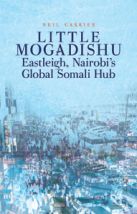Little Mogadishu: Eastleigh, Nairobi’s Global Somali Hub

Little Mogadishu is a historical and ethnographic work about the Eastleigh estate in the heart of Nairobi, Kenya. Thousands of Somali refugees have coalesced after being displaced by the war and have formed a thriving economy comprising shopping malls and hotels. This has combined with shifts in Kenya’s own pastoralist livelihoods and processes of urbanization (page 51). Starting with “low end goods”, Eastleigh has progressed to selling “high end goods” – an example of “low end globalization”, which attracts diverse and global customers as well as investors (page 94).
In this book author Neil Carrier unpicks Little Mogadishu, a name often given to Eastleigh. He seeks to understand this estate through a multidimensional approach that attends to political, social and economic processes of various spatial and temporal dimensions (pages 247 and 243). Carrier explains Eastleigh’s remarkable commercial transformation into a global Somali hub through “the movement of people, goods and capital” with networks that can be traced around the world (page 243). And as a place reliant on migration and transnational mobility, he examines Eastleigh’s “societal implications for Kenya, Somalia and the wider Somali diaspora” (page 4). As such, Carrier’s work on Eastleigh contributes to contemporary debates about migration and also links to Europe’s current refugee crisis.
Little Mogadishu starts with an Introduction by Carrier entitled “Welcome to Eastleigh”, in which he sets the scene of his research, establishes its relevance and outlines his methodology. In his introduction, Carrier also lays forth two key research questions and identifies how a study of Eastleigh links to migration, global trade and the city (page 5). The main body of this book comprises seven chapters.
Chapter 1 traces the historical change of Nairobi East into Little Mogadishu, and identifies processes of urbanization from over 100 years ago, which created fertile ground for Eastleigh’s more recent commercial transformation (page 28).
Chapter 2 adopts a macro perspective upon the rapid economic growth of Eastleigh following the arrival of Somali refugees by the 1990s. It thus “explores the real factors underpinning its transformation…that has spilled over…into many other parts of Kenya and beyond” (page 57).
“More than Little Mogadishu” is the title of Chapter 3. The large presence of Somali refugees is behind this nickname, but in this chapter, after looking at the broad identities of Somalis, Carrier highlights how contemporary Eastleigh is a migration destination for many other groups and is now a complex social field of communities and cultures (page 100).
Chapter 4 focuses on the dreams of social mobility that Eastleigh inspires and often enables – in other words the ability for small retail enterprises to transform into business empires. Thus, Carrier examines commerce within Eastleigh’s malls and “the social world within them that undergirds its success” (page 136).
In the following chapter, Carrier explores Somali entrepreneurship in Eastleigh and beyond, and two particular underpinning facets of entrepreneurship: (1) a willingness to take risks and (2) a willingness to trust others.
Chapter 6 looks at Eastleigh through the lens of commodities. In particular, Carrier analyses the types of commodities that characterize the estate and how they influence its success.
In the final chapter, Kenyan suspicion surrounding Eastleigh – in terms of its success as well as the concept of “displaced development” and the prominent “alien other” – is examined. Here Carrier contrasts the political tension caused by securitization of policy towards Eastleigh and new forms of state engagement with Eastleigh, to suggest that a “more positive and mutually beneficial relationship” is possible and worth pursuing in the future (page 216).
“Eastleigh and cities to come” is the topic of Carrier’s conclusion. In this he emphasizes the key role that the collapse of the Somali state played in Eastleigh’s impressive urban transformation and its physical, cultural and demographic complexity. He also highlights the other half of Eastleigh’s story – “the local and national processes and elements that make Eastleigh such fertile ground for these developing networks” (page 244) – while looking toward its future.
Book note prepared by Hannah Keren Lee
Search the Book notes database
Our Book notes database contains details and summaries of all the publications included in Book notes since 1993 - with details on how to obtain/download.
Use the search form above, or visit the Book notes landing page for more options and latest content.
For a searchable database for papers in Environment and Urbanization, go to http://eau.sagepub.com/

